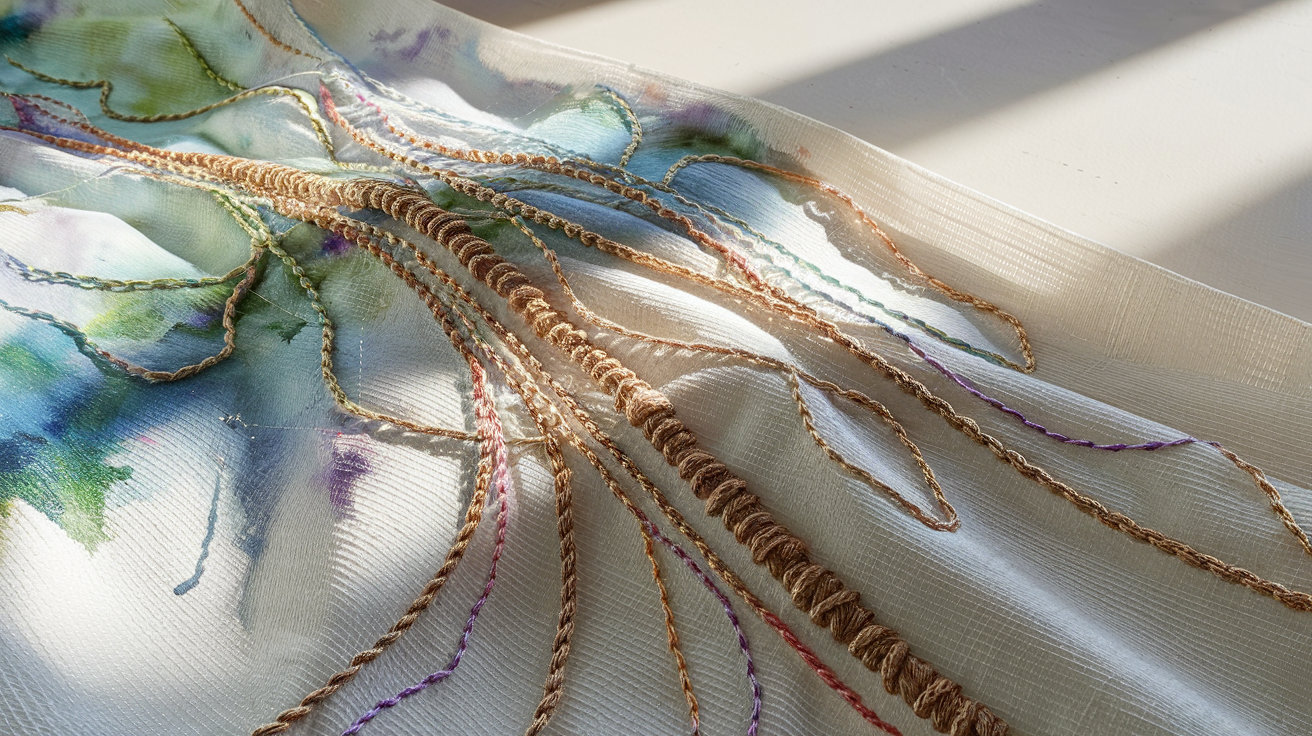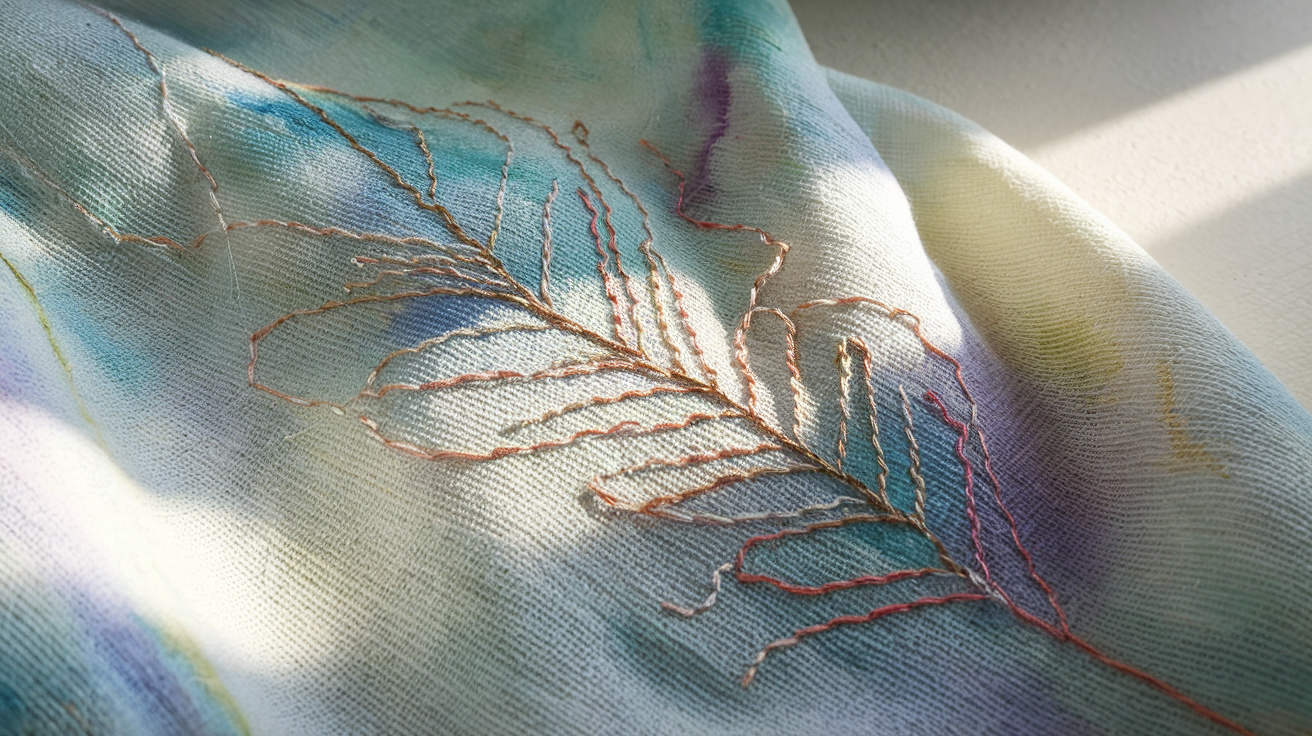Layered Embroidery On Watercolor Fabric Project

Mixed media creativity blooms where watercolor painting meets delicate stitching, inviting artists and DIY crafts lovers into a world of unique texture and color. By blending watercolor washes with tactile, hand embroidery techniques, even simple cotton muslin or linen fabric can become a stunning fiber art masterpiece bursting with artistic depth and visual dimension.
This dynamic art form transforms backgrounds into dreamy landscapes with every French knot or satin stitch, while embroidery floss anchors painterly effects in tangible narrative.
Embrace the spontaneous chaos of color and the tactile precision of embroidery—your next fabric art adventure starts here, setting the stage for Preparing Your Watercolor Fabric Base.
Preparing Your Watercolor Fabric Base
Textile art begins with selecting the right canvas for your vision.
Cotton muslin or linen fabric offers an ideal surface for creating vibrant watercolor backgrounds, forming the foundation of your next project. Pre-wash fabric to remove any fabric sizing, which improves watercolor absorption.
Then, iron fabric to ensure a smooth working surface before you begin painting. Choose pigment-rich watercolors, ideally artist-grade watercolors formulated for fabric art, and experiment with washes to craft painterly effects using harmonious colors.
Allow the painted fabric to dry fully; this step is essential for preventing color bleeding during your needlework.
When planning your embroidery patterns, a waterproof pen or water-soluble marker aids in accurate transfer.
Using a lightbox or even a sunny window ensures precise fabric transfer for your design. This thoughtful preparation supports truly professional and inspiring mixed media results, enhancing the artistic depth and visual dimension of your work.

Harmonizing Thread Colors for Impact
Watercolor fabric backgrounds invite textile artists to thoughtfully select embroidery floss, ensuring each color choice enhances the underlying painterly effects of the mixed media surface. Textile art, like watercolor painting, relies on thoughtful color application.
Hand stitching layered over washes adds a unique dimension to mixed media creations on fabric art mediums.
Needlework, specifically thread painting, can mimic the nuances of watercolor painting.
Art quilting and DIY crafts often feature such blended techniques. For this process, cotton muslin or linen fabric is ideal, with watercolor washes applied to create soft, ethereal backgrounds.
The goal is to achieve delicate stitching that complements the painterly effects, creating a true tactile art piece.
- Thread weights play a significant role—blending single- and multi-stranded floss increases texture and dimension in layered embroidery while allowing stitched areas to stand out or recede according to your fabric art vision. Consider these variations for your embroidery patterns.
- Color theory principles, such as choosing harmonious analogous threads or dynamic complementary color pairs, intensify impact and narrative, particularly when embroidery floss is placed purposefully against vibrant watercolor washes. Harmonious colors are key to a cohesive design.
- Test combinations on painted fabric swatches, using a lightbox to preview how hues interact and visualizing adjustments before stitching ensures optimal balance and creative precision for your needlework project. This is part of the creative process.
Crafting inspiration comes from observing how complementary colors interact when applied to fabric mediums.
Transitioning from impactful color harmonies, the next stage focuses on refining delicate stitching methods to bring even greater detail and artistic depth to your embroidery projects.
Textile design often benefits from this layering. Artistic expression is amplified through careful stitch selection. Home decor items can be elevated with these techniques. Fabric embellishment is a broad category encompassing these methods.
Mastering Delicate Stitch Styles
Embroidery techniques such as French knots, satin stitch, and backstitch allow needlework artists to layer intricate texture over subtle watercolor painting, transforming hand stitching into captivating tactile art. Embroidery patterns become more pronounced with these stitches. Embroidery floss in various colors adds further dimension. Stitch styles are the building blocks of detailed needlework. Mastering French knots, satin stitch, and backstitch is essential for creating nuanced textile art. These are fundamental embroidery techniques for adding artistic depth and visual dimension to any piece. When working with watercolor painting on fabric, these stitches bring a tangible quality to the ephemeral washes, enhancing the narrative of the artwork. The tactile precision of each stitch contributes to the overall richness, contrasting with the spontaneous chaos of watercolor application.
- French knots add dimension and interest by creating raised dots—a perfect way to mimic seeds or decorative elements in textile art and bring focal points to life. These provide significant texture.
- Satin stitch achieves smooth, richly colored coverage for filling shapes and contrasting beautifully with the painterly effects of watercolor washes, adding great visual dimension.
- Backstitch is essential for outlining motifs or adding linear definition, guiding the viewer’s eye through your watercolor fabric art and enhancing the narrative.
- Practice stitches on scrap fabric first to refine consistency and thread tension, ensuring your final embroidery patterns achieve both structural strength and graceful, artistic flow. This ensures tactile precision.
Fiber art thrives on the interplay between the painted surface and the stitched detail. When preparing your materials, consider using a waterproof pen or a water-soluble marker with a lightbox to transfer your design accurately onto the fabric. An embroidery hoop is indispensable for maintaining tautness, which is key for achieving clean stitch results and ensuring colorfastness after heatsetting. Remember to prewash fabric and iron fabric to create a smooth working surface before beginning your painting and stitching journey, ensuring the best outcome for your embroidery projects and fabric embellishment.
Each of these stitch styles—practiced and integrated—expands the expressive vocabulary of your layered embroidery on watercolor fabric, transforming painterly surfaces into dynamic, dimensional fiber art. The thoughtful application of thread weights and various stitch styles can create truly intricate effects, making your mixed media embroidery a standout piece of fabric art. Ultimately, this approach elevates everyday materials into unique expressions of artistic depth, perfect for a variety of applications from DIY crafts to sophisticated textile design.
- Blending single- and multi-stranded embroidery floss can increase texture and dimension in layered embroidery.
- Utilizing color theory principles, such as harmonious analogous threads or complementary color pairs, can intensify the impact of embroidery floss placed against watercolor washes.
- Practicing stitches like French knots, satin stitch, and backstitch is essential for creating nuanced textile art and adding artistic depth and visual dimension.
- Using a lightbox to test thread color combinations on painted fabric swatches allows for previewing hue interactions and making adjustments before stitching.
Creating Painterly Effects with Embroidery
Watercolor fabric art demonstrates artistic expression by merging luminous washes with hand embroidery techniques that cleverly mimic brushstrokes. Creating these celebrated painterly effects involves first prepping cotton muslin or linen fabric.
Next, apply layered watercolor washes, allowing them to dry completely to prevent unwanted color bleeding before proceeding with stitches.
Transferring embroidery patterns using a waterproof pen or watersoluble marker ensures crisp outlines atop the soft, painted backgrounds.
Select embroidery floss in harmonious or complementary tones, then experiment with satin stitch, backstitch, or French knots to build subtle gradients and tactile texture. Layering these methods yields vibrant, expressive textile art that beautifully bridges painting and needlework.
Pursue these approaches before moving into techniques for achieving artistic depth.
Layering for Artistic Depth
Layered embroidery on watercolor fabric transforms plain surfaces into dimensional, tactile masterpieces by combining mixed media techniques with thoughtful composition. After creating dreamy watercolor washes on cotton muslin or linen fabric, transfer your chosen motif with a watersoluble marker.
Utilize an embroidery hoop to maintain a smooth working area.
As needlework progresses, strategically stack satin stitch, thread painting, and even metallic threads to heighten visual dimension and create intricate effects.
Incorporate additional materials—like beads or fabric scraps—to enrich the texture and narrative of the work. This approach to textile painting ensures every embroidery project possesses significant depth, guiding the viewer’s eye and amplifying artistic impact for striking results in fiber art.
Key Techniques for Painterly Embroidery
- Watercolor fabric art combines luminous washes with hand embroidery techniques that mimic brushstrokes.
- Cotton muslin or linen fabric are suitable bases for watercolor washes, which should be allowed to dry completely to prevent color bleeding.
- Waterproof pens or watersoluble markers are used to transfer embroidery patterns onto the painted fabric.
- Embroidery floss in harmonious or complementary tones is used with stitches like satin stitch, backstitch, or French knots to build gradients and texture.
Choosing Embroidery Patterns Wisely
Textile art offers rich avenues for creativity, enabling you to find suitable patterns, adapt existing designs, or create unique motifs that perfectly harmonize with your painted backgrounds. Mixed media artists find success with embroidery patterns featuring clear lines, accentuating both the soft watercolor washes and the delicate stitching effects.
Fabric art often begins with sketching directly onto the painted surface using a waterproof pen or watersoluble marker, ensuring the motif remains visible throughout your process.
It’s beneficial to adapt embroidery patterns, balancing their complexity with the background’s harmony, preventing stitches from overwhelming softer painted areas.
For further inspiration, consider motifs inspired by nature, abstract linework, or experiment with thread painting for a distinctly personalized touch. Transferring your selected design using a lightbox prepares your piece for the next exciting stage: weaving in mixed media needlework possibilities.
What are Mixed Media Techniques
Mixed media in textile art opens up new creative possibilities by artfully combining watercolor painting with hand stitching, forging vibrant layers of color, texture, and narrative within each creation.
Needlework projects gain significant richness when materials like cotton muslin or linen fabric are united with pigment-rich watercolor washes and a variety of stitch styles, such as the classic French knots or the smooth satin stitch. Textile art flourishes when exploring methods like painting both before and after stitching, which allows for intricate effects and unique, painterly finishes.
Proper use of an embroidery hoop stabilizes your fabric, supporting consistent, controlled stitches.
Essential for successful mixed media outcomes is deliberate layering—balancing thread weights and color contrasts for cohesive visual results, embracing experimentation throughout your creative process to achieve harmonious artistic expression and complex visual dimension.
Layered Embroidery on Watercolor Fabric
Fiber art transforms plain fabric into painterly, tactile art through the unique mixed media technique of layered embroidery on watercolor fabric, blending soft watercolor washes with delicate hand stitching.
This approach is ideal for DIY crafts and artists seeking to merge painting and needlework for striking visual results, adding dimension, texture, and artistic depth to your textile works.
Embroidery floss selection impacts contrast and depth; consider texture and color theory when choosing your threads.
Artist-grade watercolors produce stronger, longer-lasting hues on textile. It is important to choose watercolor-safe fabric like cotton muslin or linen fabric.
Pre-wash fabric to remove sizing for best watercolor absorption.
After painting, iron fabric for a smooth working surface.
Waterproof embroidery transfer pens prevent design smudging. An embroidery hoop is essential for smooth stitching.
Layering techniques yield better dimension.
Embroidery Techniques and Material Insights
Embroidery patterns can be adapted to balance complexity and harmony, preventing stitches from overpowering soft backgrounds. Experiment with thread painting for a personalized touch.
Transferring your chosen design using a lightbox sets the stage for seamless integration into your embroidery projects.
Needlework supplies are varied; embroidery floss selection impacts contrast and depth.
Art quilting often benefits from these blended approaches. Textile painting opens up new avenues for fabric embellishment.
Backstitch and other stitch varieties affect the finished appearance. Pigment-rich watercolors and artist-grade watercolors create vibrant effects.
Color bleeding can be managed with proper drying times.
Heatsetting and handwashing ensure colorfastness.
Fabric sizing impacts watercolor absorption and requires pre-washing. A smooth working surface and an ironed fabric are key for neat work.
Harmonious colors and complementary colors guide your palette. Thread weights allow for intricate effects.
Embracing the creative process sparks crafting inspiration for home decor and unique textile design.
| Key Materials for Mixed Media Textile Art | Recommended Techniques |
|---|---|
| Artist-grade watercolors, Cotton muslin or Linen fabric, Embroidery floss | Layered embroidery, Thread painting, Combining watercolor washes with hand stitching |
| Waterproof pen or Watersoluble marker, Embroidery hoop | Adapting embroidery patterns, Balancing complexity with background harmony |
| Lightbox for design transfer | Experimenting with stitch styles (e. g. , French knots, satin stitch) |
Safeguarding Your Textile Artistry
Preserving Your Creations: Finishing Methods
Cotton muslin and linen fabric require thoughtful finishing techniques offering durability for your fabric art. Begin by prewashing fabric, then apply watercolor washes using pigment-rich, artist-grade watercolors for vibrant backgrounds.
After drying, transfer your embroidery patterns with a waterproof pen or watersoluble marker.
Utilize an embroidery hoop for smooth, even stitches, ensuring your delicate stitching and thread painting maintain crisp definition and artistic depth.
Essential Care for Your Masterpieces
For maintenance, handwashing your textile art in cool water, then laying it flat to dry, preserves the softness of watercolor painting and the tactile effects of intricate embroidery.
Avoid machine dryers and high heat; instead, use a pressing cloth and iron on the reverse as needed. This care ensures your fiber art retains its vibrancy and visual dimension.
Displaying Your Textile Art
Display options such as conservation framing with UV-filtering glass and acid-free backings, or storing flat in acid-free tissue, protect your needlework from light, dust, and humidity.
This ensures your art quilting, mixed media, or hand stitching pieces retain their brilliance. Consider framing to showcase your painterly effects and the unique texture of your work.
Supporting Information for Textile Art Care
- Prewashing fabric, such as cotton muslin and linen, is a crucial initial step for durability in fabric art.
- Watercolor washes using artist-grade watercolors are recommended for vibrant backgrounds on textile art.
- Handwashing in cool water and laying flat to dry are advised for preserving the quality of textile art.
- Conservation framing with UV-filtering glass and acid-free backings helps protect needlework from environmental damage.




